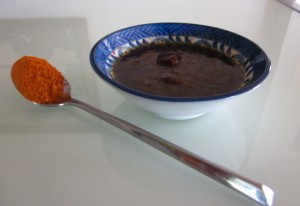Cherry Pickles, Indian Style
Thanks to our friends at the Washington State Fruit Commission, we’ve got cherries on the brain - and on the stove, and in jars. For the second year in a row, we’ve been gifted with bing cherries like nobody’s business. In celebration, we’ll be dishing up the myriad ways you can preserve cherries all week long. Today’s dispatch comes from the kitchen of CAA comrade Venkat Balasubramani.

Venkat's pickled cherries.
Even though I grew up in southern California, my mom brought many kitchen traditions from India, including refrigerator-style pickles. One of the most common type of pickles from South India is made with green, unripe mangos. My mom always made a version of this with a bunch of other (locally available) fruits, such as cranberries and strawberries. The recipe is amazingly simple and I’ve been doing the same here in Seattle with a variety of fruit (cranberries, tayberries, strawberries and mango, a perennial favorite). I was at the West Seattle Farmer’s Market the other day and saw some cherries and decided to give them a try.
Here’s the basic recipe:
Ingredients
1/4 pound cherries, pitted
1 1/2 teaspoons salt
1 1/2 teaspoons plain chilli powder (Do not use a blend or ground cayenne, as it will be too hot; in in doubt, use chilli powder from an Indian grocery store. They make this available among other things for pickling)
1 tablespoon black mustard seeds
1/2 teaspoon asafeotida powder (available in Indian or Asian markets)
Method
Liberally sprinkle the cherries with salt and chili powder. Let it sit for a day or two in a covered bowl in the refrigerator so the flavor soaks in. Heat up olive oil in a pan. Once the oil gets hot, throw in the mustard seeds. Once the mustard seeds start popping, give it about 30 seconds and throw in the asafoetida.
Remove the mixture from the stove, and mix in the cherries, while the oil is still hot. Store in a cover container in the refrigerator.
Notes: I always advise going easy on the asafoetida, but the chili powder and salt are definitely “to taste.” The salt and oil act as natural preservatives, but I recommend consuming it within a month or two. This should be no problem because the pickles are out of this world.
Venkat Balasubramani is a Seattle-based lawyer who happens to have an avid interest in pickles and spices.
Comments (0)
0